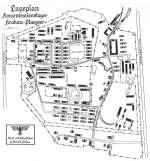 |
| Camp Map |
 |
| Overview #1 * See map! |
Plaszow was originally a forced labour camp, and subsequently became a concentration camp.
Its official designation was
Zwangsarbeitslager Plaszow des SS- und Polizeiführers im Distrikt Krakau.
The construction of the camp began in
summer 1940. Its first prisoners were Poles. In
1941 the camp
was extended and the first Jews were deported there. The site chosen compromised two Jewish cemeteries:
 |
| Overview #2 * See map! |
the new Jewish cemetery on
Abraham Street, and the old Jewish cemetery on
Jerozolimska Street.
This area also included Jewish community property, and private Polish dwellings whose owners had been evicted.
From time to time the camp was enlarged, its maximum size in
1944 being 81 ha (200 acres).
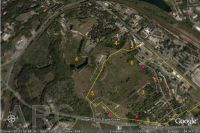 |
| Google Overview |
The camp was encircled by an electric double apron barbed wire fence, 4 km in length.
Between the two fences there was a
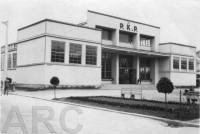 |
| Plaszow Station in 1939 |
ditch filled with water. It was guarded by thirteen guard towers,
close together and equipped with machine guns, telephones and revolving searchlights.
The camp guards consisted of Ukrainians until it was restructured into a concentration camp, when 600 SS men
from the
SS-Totenkopfverbände took over.
The camp was divided into several sections: the German quarters, the factories and the camp itself,
which was divided into menís and womenís compounds, each with separate subsections for Poles and Jews.
The main entrance to the camp was located on
Jerozolimska Street.
The area was not suitable for a camp, as it was situated mainly on rocky, hilly ground and malaria-infested
marshland. However, it directly adjoined the local stone and lime quarries.
Many people lost their lives during the construction of the camp, including the Jewish architect
Diana Reiter, who had previously worked for the
Krakow district
building department, and the owner of the
Bonarka brick works,
Ingber.
Reiter was executed by SS man
Hujar
on commandant
Amon Göthís order, because a wall which was under her
supervision collapsed.
Ingber was killed by
Göth himself as he was slow in allocating workers.
During the liquidation of the
Krakow Ghetto, which was directed personally by
SS-Sturmbannführer Willi Haase
on
13 - 14 March 1943, most of the Jewish inhabitants were sent to
Auschwitz, where they arrived on
16 March.
Approximately 2,000 Jews were murdered in the streets, and buried in a mass grave in Plaszow. 8,000 Jews,
being able for work, were interned in Plaszow.
In
early July 1943 a separate camp was established for the "educational retraining" of
Polish prisoners
charged with disciplinary or political offences, commanded by
SS-Oberscharführer
Landsdorfer. Disciplinary prisoners were held there for several months,
while political prisoners were given unlimited terms of "re-training". The Polish camp also contained several dozen
Gypsy families, including small children.
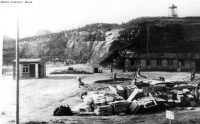 |
| The Quarry * |
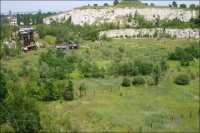 |
| The Quarry in 2004 |
The inmates worked in workshops. The working day was divided into two 12-hour shifts. The prisoners were
undernourished, and the SS guards treated them with the utmost cruelty.
Because of a lack of the usual striped camp uniforms, yellow paint stripes were daubed on prisonerís civilian
clothing in order to discourage attempted escapes.
The work in the two stone quarries was extremely hard. Even women were employed in this kind of work.
A prolonged stay in the quarries usually resulted in death. The quarries were under the command of
SS man
Lehmer.
The number of inmates held in Plaszow varied over the years. Prior to the liquidation of the
Krakow Ghetto it had 2,000 inmates. In
March 1943,
the average barracks contained 150 people in an area of about 80 square metres. By the
second
half of 1943, its population had risen to 12,000, and by
May - June 1944 the
number of prisoners had increased to 24,000, including 6,000 - 8,000 Jews from Hungary.
Plaszow also contained German criminals who were employed on various camp duties. The number of these
permanent prisoners, who were given individual numbers, was estimated at 24,000, with an unknown
number of temporary prisoners.
The daily food ration for each detainee was 200 grams of bread, 150 grams of cheese, 300 grams of
coffee substitute and hot water soup. The rations were distributed once a week; occasionally one egg was added.
Any Jewish labourers caught smuggling food in were executed.
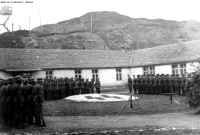 |
| SS Men at Plaszow * |
The first commander of Plaszow was
SS-Unterscharführer Horst Pilarzik,
followed by
SS-Oberscharführer Franz Müller.
Göth took over from him from
February 1943
until his arrest by the SS in
September 1944. Other notable SS men,
employed at Plaszow, were
Hujar, John, Zdrojewski, Landesdorfer, Eckert and
Glazar, who lived in the
Graues Haus which was built before the war and incorporated
into the camp.
Göth was personally responsible for the brutal treatment
of Jewish prisoners. Here is one example amongst hundreds, from the testimony of
Henryk Bloch:
"
It was a beautiful hot day, June or July. The German found some
bread and other bits of food. He
ordered us to wait, as he had to report this to his chief. He duly reported to his chief and
Göth came towards us. A thorough search of all began, we were ordered
to place everything we had in front of us.
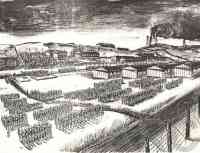 |
| Plaszow - Drawing by J. Bau |
We did this, in the meantime throwing away what we could, so that as little as possible should be there
for him to see. The Ukrainian camp guards surrounded us. Göth ordered
whips to be brought there from his home, and the beating commenced. It was carried out by
Göth himself, using whips with long leather
strands and also a heavier type whip, like a rhino whip.
Göth was unarmed,
wearing a silk shirt, and a sort of blouse over his shoulder; he did not have a military belt on either.
He promised he would have the whole group of 30 shot if we did not disclose where the money for the food
items came from, where they were bought, and what methods were used to make contact with the population
outside the camp. Beating at random, he took a rifle from Kunde, reloaded,
and without taking aim started shooting at us from a distance of 1 - 2 steps.
He ordered us into 3 rows of 10,
and started shooting. I was standing in the first row of ten. The first shot went right through my hand, the
bullet then struck and penetrated the head of the man standing next to me, and then into the neck of a
third man. He repeated this, and fired a second time, aiming somewhat better and this time killing one of
the 30. He then beat us with the rifle butt as he had run out of ammunition for that weapon. He then threw
the rifle aside, and ordered his deputy to start beating us."
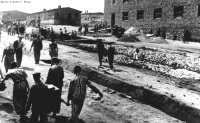 |
| Forced Labourers * |
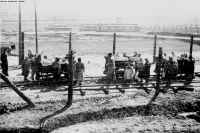 |
| Women Inmates pushing
Tippers * |
On
14 May 1944 a so-called "health appel" was conducted, under the supervision of
Göth and the camp's SS doctor
Blancke.
As a result approximately 1,400 persons they considered unfit for work were sent to
Auschwitz, where the whole transport was gassed on arrival on
24 May in
Birkenau.
This "action" was conducted on the initiative of
Göth, in order to make
room for transports of Hungarian Jews.
Approximately 8,000 people (among them inmates of the
Montelupich prison in
Krakow) are estimated to have been murdered at three killing sites within
the camp:
Chujowa Gorka (south-western part),
Cipowy
Dolek (south-eastern part) and the northern part of the old cemetery.
The approach of the Russian Army in the
summer of 1944 signalled the liquidation of the
camp, which was preceded by the exhumation and burning of all corpses at
Chujowa
Gorka. During
July and August 1944 transports of prisoners left Plaszow for
Auschwitz, Stutthof, Flossenbürg, Mauthausen, and other KZs.
On
13 September 1944 Göth was arrested by the
SS-und Polizeigericht VI in
Krakow. He was accused of misappropriating
valuables and property from the victims of the camp and from
Krakow and the
Tarnow Ghetto Jews.
Göth did in fact
conduct frequent
searches and confiscations. He was also accused of stealing furniture and property during the ghetto liquidations.
His assistant, the
Lagerälteste (camp elder)
Chilowicz,
had helped him amass stolen valuables and other property.
Chilowicz was
the director of the Jewish
Ordnungsdienst and had full charge of the camp, with
Göthís entire backing.
However, as the liquidation of the camp drew near,
Göth arranged for
Chilowicz and his family to escape, but ordered that during the escape
Chilowicz and all his family should be shot, thus ridding himself of a key
witness.
On
14 January 1945, one day before the liberation of
Krakow by the Red Army, the last prisoners - 178 women and 2 boys - were sent
to
Auschwitz.
Trials:
Mosbach,
1961:
Müller, Franz-Joseph - life sentence
(Haftstättenpersonal ZAL Plaszow, Haftstättenpersonal
ZAL Prokocim,
Haftstättenpersonal
ZAL Biezanow)
Crimes commited in HS ZAL Plaszow, HS
ZAL Prokocim, HS ZAL Biezanow, in
June 1942 - November 1943. Individual shootings of a number of Jewish forced laborers
for different reasons. Mass shooting
of 37 Jewish women, who had been lodged illegally in a labor camp by a German company; of 10 ill Jews from the sick-bay
of the Plaszow camp, of 11 Jews from a labor column, because they allegedly did not march in the appropriate tight order,
of at least 11 members of an
Einsatzkommando of forced labor camp
Prokocim,
who had attempted to provide themselves with food along the way, as well as of 6 ill or wounded prisoners at the
time of the liquidation of
ZAL Prokocim in
March 1943.
Kiel,
1968:
Hei., Hermann - proceeding suspended
Mül., Franz Josef - acquittal
(Polizei Sipo
Krakau, Haftstättenpersonal
ZAL Bochnia)
Crimes committed in
1942-43: In
Krakau, Bochnia, Wieliczka,
HS ZAL Plaszow -
Deportations to
KL Belzec und
Auschwitz.
Single and mass killings of Jews.
Berlin,
1973:
Bigell, Karl-Heinz - life sentence
(Haftstättenpersonal
ZAL Plaszow)
Crimes commited in HS ZAL Plaszow, in
AprilĖMay 1943: Erschiessung eines
jüdischen Häftlings, der von den vom Lagerkommandanten
Göth
und dem Angeklagten auf ihn gehetzten Hunden schwer verletzt worden war.
Hannover,
1979:
Hei., Kurt Heinrich August Dietrich - acquittal
(Polizei Sipo Krakau)
Crimes commited in
Krakau, HS ZAL Plaszow, in
1942-43:
Deportation der
Krakauer Juden ins
KL Belzec in drei Aktionen sowie
Einzelerschiessungen im Verlaufe dieser 'Aussiedlungsaktionen'. Erschießung von 30-40 Polen, darunter
Geistliche und Juden, im ZAL Plaszow.
Photos:
O'Neil Collection
Yad Vashem (Plaszow Aerial Photo)
GFH
*
Sources:
The Trial of Amon Goeth - Unpublished English Translation. Courtesy of R. O'Neil
Gutman, Israel ed.
Encyclopedia of the Holocaust. Macmillan Publishing Company, New York, 1990
Booklet:
The Plaszow Concentration Camp No author, no editor
The Krakow Diary of Julius Feldman. Quill Press, Kirton, 2002
Map drawn by Joseph Bau.
© ARC 2005


















